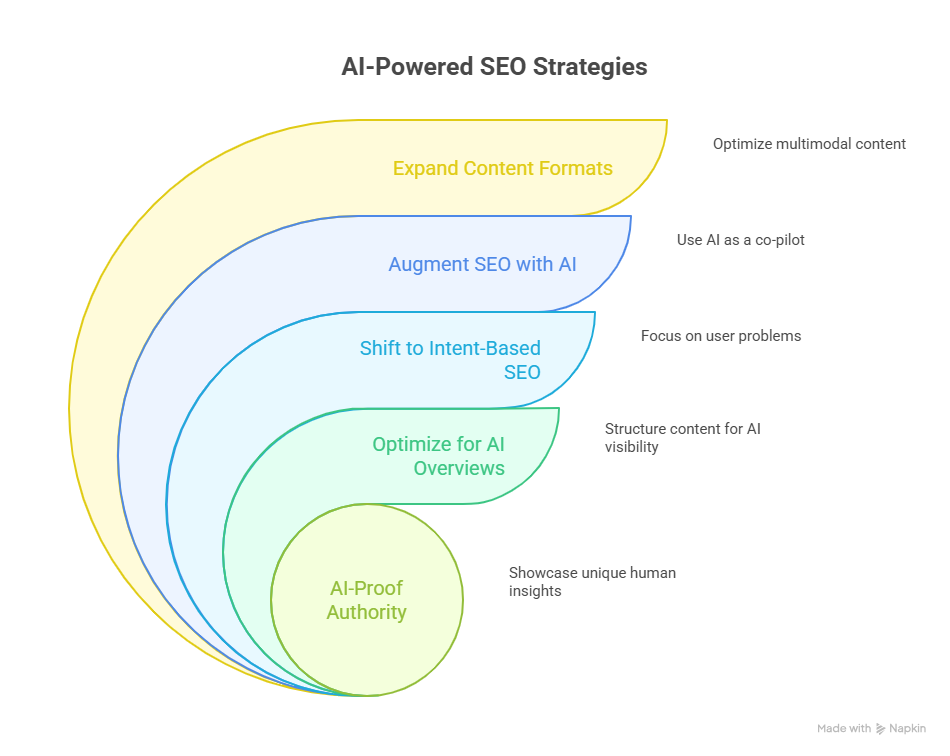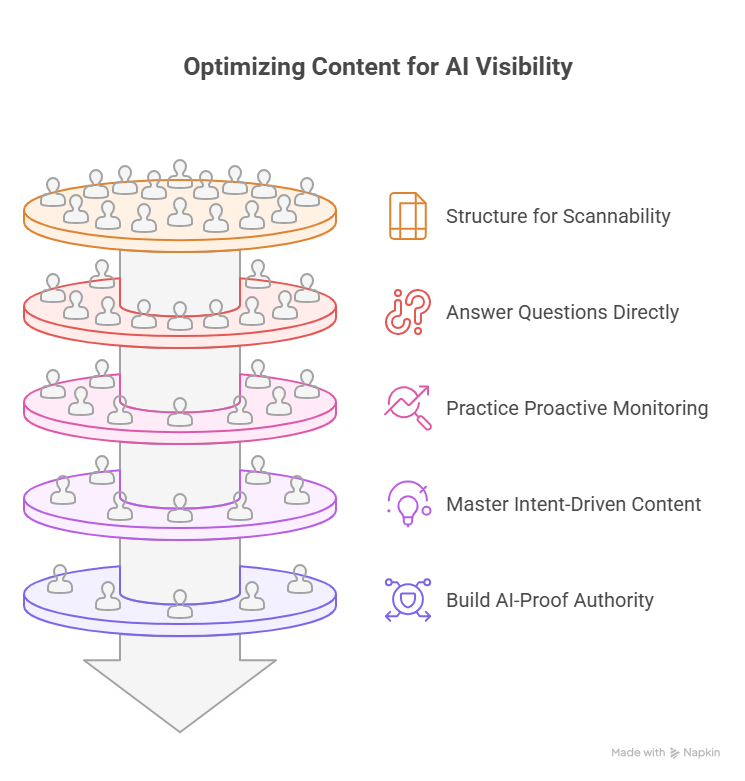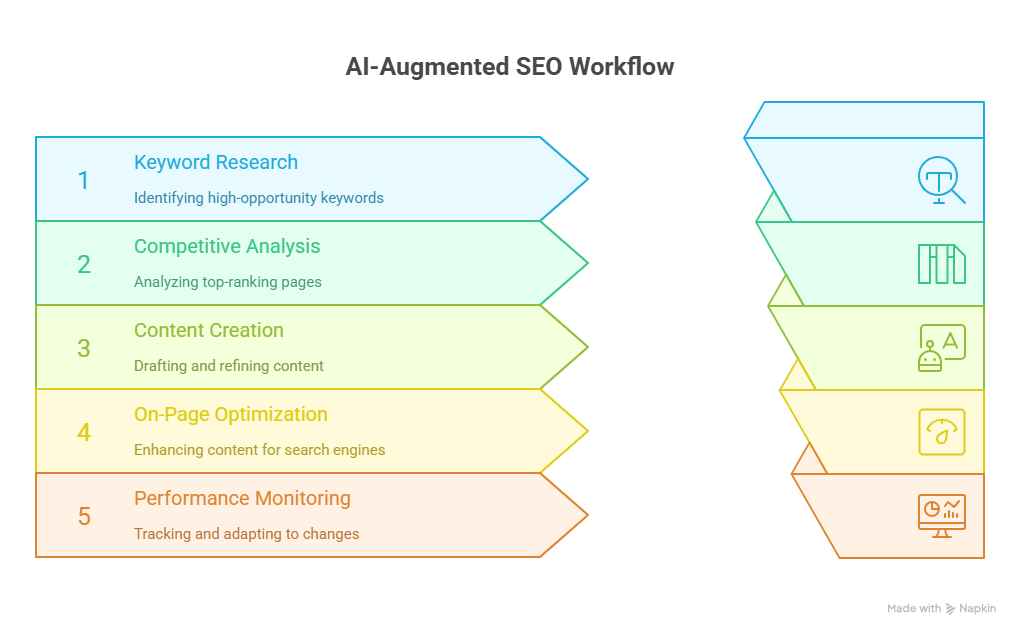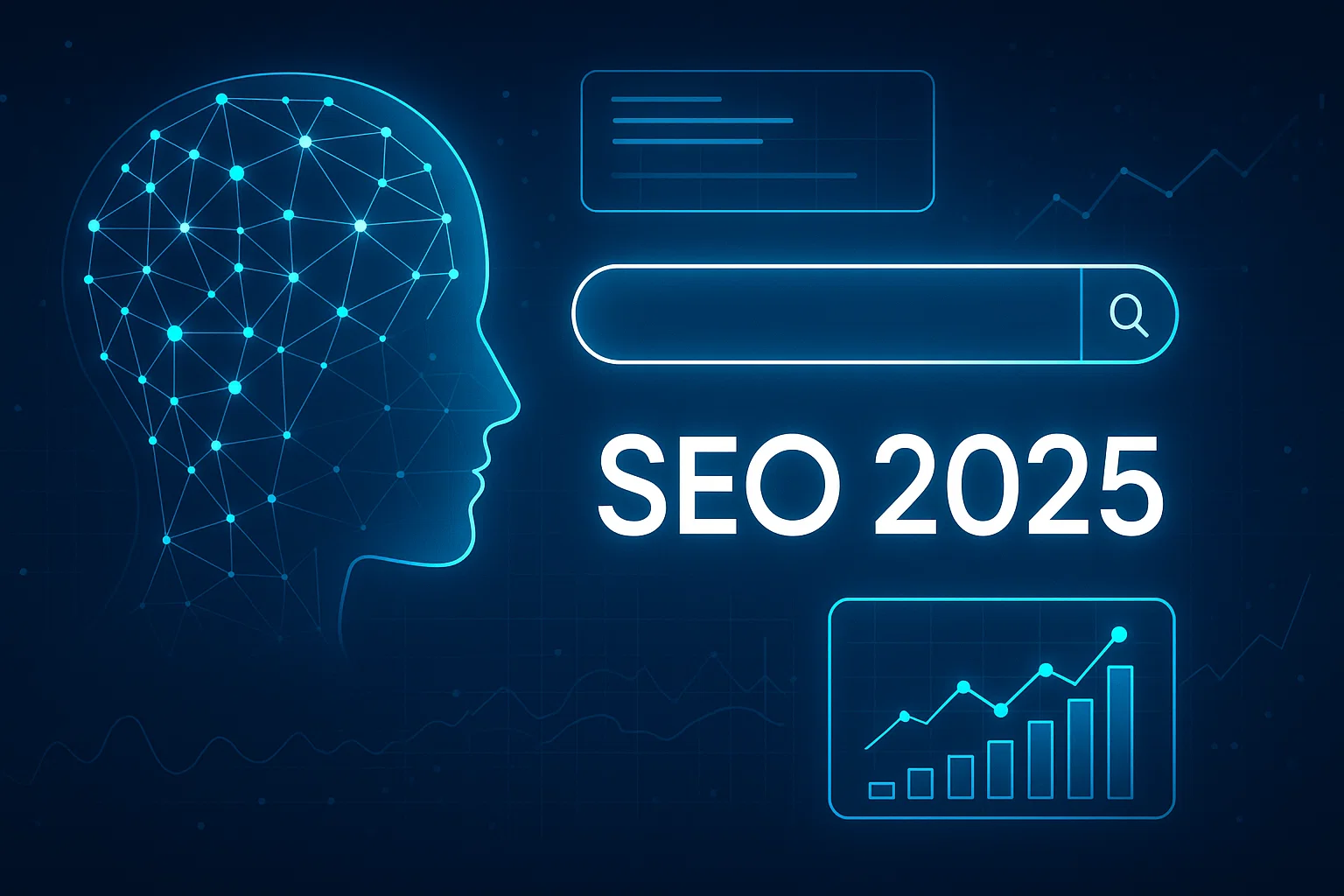Top AI SEO Strategies to Dominate Search in 2025
Key Takeaways
Ready to get ahead in the new age of AI-powered search? The game has changed, but the opportunity is bigger than ever for those who adapt. Here’s a quick look at the core strategies you need to master to dominate the SERPs of tomorrow.
- Optimize for AI Overviews by structuring content with clear headings, lists, and direct answers. AIOs cite an average of ~11 different sources, creating massive opportunities for visibility beyond the traditional top 10 results. Learn more about SEO 2025.
- Shift from keywords to intent by focusing on the «problem behind the query.» Use AI tools to analyze SERP features and build comprehensive pages that satisfy the entire user journey, not just a single keyword. Discover how to leverage AEO Optimization.
- Build «AI-proof» authority with content that machines can’t replicate. Showcase irreplaceable human insights through original research, unique case studies, and contributions from industry experts to demonstrate E-E-A-T.
- Augment your SEO workflow with AI for research and analysis, not just content generation. Treat AI as a powerful co-pilot, but remember that human oversight is non-negotiable for ensuring quality, accuracy, and brand alignment. Explore Content Automation for SEO 2025.
- Expand beyond text-only content by optimizing your videos, images, and audio with transcripts and descriptive data. AI now analyzes these multimodal formats, making your entire content library discoverable as potential answers.
- Use schema markup strategically as a universal language for search engines. This provides explicit context about your content, ensuring it’s correctly interpreted by AI across all formats, from articles to videos.
Dive into the full article to get the detailed, step-by-step guidance behind each of these powerful strategies. Check out NeuraISEO Opportunities for more insights.
Table of Contents

Introduction
That feeling when you hit the top of Google, only to find an AI-generated answer sitting directly above your result. It’s a moment every SEO and marketer is now facing.
This isn’t the end of SEO; it’s the start of a new game. We’ve moved beyond the classic «10 blue links» and into a conversational, answer-first search experience.
Success is no longer just about driving traffic. It’s about becoming the trusted source that AI systems cite directly, putting your brand front and center.
But how do you optimize for an algorithm that’s constantly learning? It’s not about chasing updates; it’s about building a fundamentally stronger strategy. This guide gives you the complete, actionable playbook.
We’ll show you exactly how to:
- Win valuable citations in AI Overviews
- Shift from keywords to a true user-intent model
- Build «AI-proof» authority with unique human experience
- Integrate AI tools to create a smarter, faster workflow
This is your roadmap for moving from reactive tactics to a proactive strategy that dominates search in 2025 and beyond. Visit NeuraISEO to start dominating SEO.
The New SERP: Winning in the Age of AI Overviews
The search results page you knew is already a relic. We’ve moved past the classic «10 blue links» and into a conversational, answer-first search experience.
At the top of this new landscape are AI Overviews (AIOs)—direct, AI-generated summaries that answer user questions right on the results page. This is accelerating the trend of «zero-click searches,» forcing a strategic pivot. Success is no longer just about driving traffic; it’s about becoming the definitive source for the answer itself.
The Anatomy of a Winning AIO Citation
So, how do you get your content cited in an AI Overview? It’s a completely new game with new rules.
Current data shows AIOs cite an average of ~11 different sources, and there’s surprisingly low overlap with the top 10 traditional organic results. This creates a massive opportunity for brands to gain visibility, even if they aren’t ranking number one.
AI parsers favor content that is:
- Direct: Answers the user’s question clearly and concisely.
- Factual: Provides accurate data, steps, or definitions.
- Well-Formatted: Uses simple headings, bulleted lists, and FAQ sections that are easy to process.
How to Optimize for AI-Generated Summaries
You can adapt your content strategy today to start winning these valuable citations. It’s not about fighting AI; it’s about making your content the most helpful and easiest for AI to understand.
Start by focusing on these three core actions:
- Structure for Scannability: Use schema markup (like FAQ, HowTo, and Article) to give search engines explicit context about your content’s purpose.
- Answer Questions Directly: Create dedicated sections within your articles that explicitly ask and answer common questions related to your topic. Think like a user and write the answer you’d want to see.
- Practice Proactive Monitoring: Regularly check how your brand and content appear in AI-generated answers. Use Google’s feedback mechanisms to report inaccuracies and protect your brand’s reputation.
Ultimately, winning in the age of AIOs means shifting your focus from chasing links to providing clear, authoritative answers that solve a user’s problem instantly.
Beyond Keywords: Mastering Intent-Driven Content Strategy
The days of obsessing over exact-match keywords are over. Modern search AI uses advanced natural language processing to understand context, not just a string of words.
This is the power of semantic search. It grasps the meaning behind a query, connecting it to related concepts, synonyms, and the user’s ultimate goal.
The strategic focus has fundamentally changed. We’re no longer asking, «what words did they type?» Instead, we must ask, «what problem are they trying to solve?» This shift is the key to creating content that resonates with both users and algorithms.
Using AI to Uncover True User Intent
Your goal is to become a detective of user intent, and AI tools are your best magnifying glass.
Use them to automate the analysis of the entire search landscape and map out what your audience really wants.
- Mine SERP Features: Systematically analyze «People Also Ask,» «Related Searches,» and AI Overviews. These are direct clues to the pain points and follow-up questions your audience has.
- Cluster Topics: Use AI to group thousands of related queries into thematic clusters. This shifts your focus from chasing single keywords to addressing a complete user need.
For example, a query for «best CRM» hides multiple intents: comparing features (informational), seeking reviews (commercial), or wanting a free trial (transactional).
Crafting Content That Satisfies Intent
Once you understand the full range of intents, you can build content that delivers a complete solution.
Structure your pages to be comprehensive resources, not just single-answer articles. Anticipate the user’s next question and answer it before they even have to think of it.
The ultimate goal is to create pages that solve problems completely. When you satisfy every aspect of a user’s query, you reduce their need to click back to the search results. This is one of the most powerful signals of value you can send to Google’s AI.
Stop creating content that just targets keywords. Start building comprehensive resources engineered to satisfy the full spectrum of user intent from start to finish.
Building «AI-Proof» Authority with Expertise and Originality
In a world increasingly flooded with AI-generated content, your most powerful differentiator isn’t a new tool—it’s your verifiable human experience. This is the core of E-E-A-T (Experience, Expertise, Authoritativeness, and Trustworthiness).
AI search systems are actively looking for signals that prove your content is credible. They analyze author bios, professional citations, and brand mentions across the web to determine if your information can be trusted over a generic, synthesized answer.
Actionable Strategies for Demonstrating Authority
To build authority that AI respects and users trust, you need to create content that simply cannot be replicated by a machine. Focus on originality and prove your credentials on the page.
Your goal is to build a moat around your content with irreplaceable human insights.
- Showcase First-Hand Experience: Publish original research, detailed case studies, and proprietary data. Share the results of an experiment you actually ran.
- Leverage Expert Voices: Feature direct quotes, interviews, or contributions from recognized leaders in your industry. This attaches their authority to your content.
- Build Your Digital Entity: Strengthen your brand’s presence as a recognized «entity» online. This means ensuring a robust Google Business Profile, consistent brand information across platforms, and earning mentions on reputable third-party sites.
The Role of Transparency and Trust
Building trust in the AI era isn’t about hiding your tools; it’s about being transparent. In fact, research shows that 80% of consumers are neutral or positive about brands using AI when it’s disclosed properly.
Clearly label where AI has assisted in your content creation process. More importantly, ensure every piece is meticulously reviewed by a human expert for accuracy, tone, and alignment with your brand’s unique perspective. Make your expertise obvious on every page.
Ultimately, your goal is to make your content «AI-proof» by doubling down on what makes it human. By embedding genuine experience and unique data into your work, you create value that algorithms are designed to find and reward.

The AI-Augmented SEO Workflow: Tools, Automation, and Analytics
Winning at modern SEO isn’t about working harder—it’s about working smarter by integrating AI directly into your daily workflow. This approach automates tedious tasks and delivers insights that were previously impossible to uncover at scale.
By augmenting your team’s expertise with AI, you can move faster and make more strategic, data-driven decisions.
Supercharging Research and Strategy
The foundation of any successful SEO campaign starts with deep research, and this is where AI first provides a massive advantage. It transforms tedious manual analysis into a rapid, strategic exercise.
AI-powered tools can create a data-driven blueprint for your content by automating critical research tasks:
- Advanced Keyword & Topic Research: Go beyond simple search volume. AI uses natural language processing (NLP) to uncover high-opportunity, low-competition long-tail keywords and entire content gaps your competitors have missed.
- Competitive Analysis at Scale: Instantly analyze the top-ranking pages for a query. AI deconstructs their structure, semantic richness, and tone, showing you exactly what user intent they satisfy and how to build something better. Compare with Neura iSEO vs Frase .
Streamlining Content Creation and Optimization
With a solid strategy in place, AI becomes a powerful co-pilot for your content team. The key is to use it for acceleration, not complete automation, ensuring quality and authenticity remain.
Treat AI as your most efficient junior writer and editor. Human oversight is non-negotiable to ensure accuracy, originality, and brand alignment.
Practical applications include:
- AI-Assisted Writing: Use generative AI to draft detailed outlines, create initial content blocks, or refine existing copy for clarity and tone.
- On-Page SEO Optimization: Leverage tools that analyze your content in real-time, providing actionable suggestions for internal linking, entity inclusion, and improving semantic relevance.
Real-Time Monitoring and Iteration
AI finally shifts performance tracking from a reactive, backward-looking process to a proactive, forward-looking one. Instead of just reporting on what happened, you can anticipate what’s next.
This allows you to adapt to market changes almost instantly. You can monitor SERP volatility, track competitor movements, and use predictive analytics to identify which content changes will likely have the biggest impact on your goals.
This creates a powerful feedback loop: Analyze -> Act -> Measure -> Iterate. With AI, this cycle becomes faster and more effective, giving your team a decisive competitive edge.
Beyond the Web Page: A Multimodal Strategy for 2025
Your audience’s search for answers no longer starts and ends with a Google search bar. It’s happening on YouTube, TikTok, and inside conversational AI engines like Perplexity.
A text-only strategy is no longer enough to maintain visibility. AI systems are now incredibly skilled at analyzing and surfacing insights directly from non-text formats, making your videos, images, and audio files first-class SEO assets.
Optimizing for a Multimodal World
To win in 2025, you need to make your expertise understandable to AI, no matter the format. Think of it as creating a universal translation layer for your best ideas.
This means optimizing every piece of content you produce:
- Video & Audio: Create detailed transcripts and use descriptive, query-focused titles. Structure your videos with clear chapters so AI can easily parse key moments.
- Images & Infographics: Use descriptive alt text and file names. Optimize for visual search, as these assets can be pulled directly into AI-driven results.
- Structured Data: Use schema markup as a universal language for AI. It spoon-feeds context about your content, ensuring it’s interpreted correctly across every format.
Distributing and Repurposing for Maximum Reach
Adopt a «create once, distribute everywhere» mindset. This isn’t about creating more work; it’s about making your core ideas work harder and smarter.
Picture this: one piece of cornerstone content, like an original research report, is strategically repurposed. It becomes a deep-dive blog post, a summary explainer video for YouTube, a series of quick tip clips for social media, and a compelling infographic for LinkedIn.
This approach builds your brand’s entity authority and ensures your expertise is consistently visible across all the channels where your audience is spending their time.
By treating every format as a vital part of your SEO strategy, you meet your audience where they already are and build a brand presence that AI algorithms can’t ignore.

Conclusion
Navigating the new era of search isn’t about fighting AI; it’s about partnering with it. The brands that dominate in 2025 and beyond will be those who shift their focus from chasing rankings to becoming the most trusted and comprehensive source of answers for their audience.
This is your opportunity to move faster, create more value, and build an authority that algorithms are designed to reward.
Here are the key strategies to implement now:
- Optimize for Citation, Not Just Clicks: Reformat your most valuable content with clear headings, direct answers, and structured data to win placements in AI Overviews.
- Solve Problems, Don’t Just Target Keywords: Use AI tools to map out the full spectrum of user intent behind a query, then build comprehensive resources that address every question.
- Double Down on Human Expertise: Make your content «AI-proof» by embedding it with original data, first-hand experiences, and quotes from industry experts.
- Think Beyond the Blog Post: Treat your videos, images, and audio as first-class SEO assets. Optimize them with transcripts and descriptive data to be found everywhere.
Your first step is simple: Choose one of your most important articles and audit it through this new lens. Can you reformat a key section to directly answer a question? Can you add a simple FAQ schema? Start there.
The future of search doesn’t belong to those who simply game the algorithm. It belongs to those who genuinely serve the user with clarity and expertise. Become the definitive answer, and the visibility will follow.

